
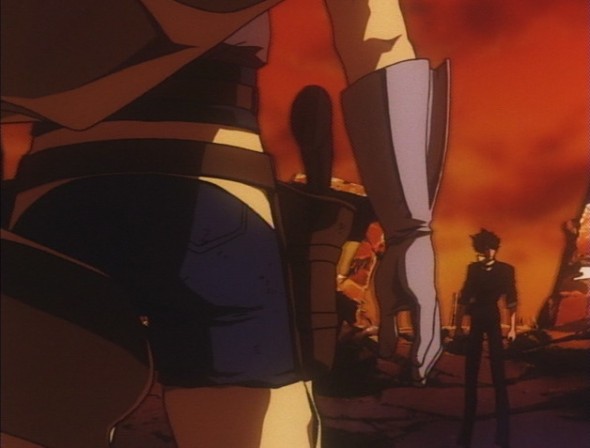
The movie references fly fast and fierce in this episode, and the most notable one right off the bat is to the spaghetti westerns of Sergio Leone. Andy’s leitmotif is a brilliant, loving pastiche of Ennio Morricone’s music for these movies, right down to the whistling, the mouth-harp, and the blurring of diegetic and non-diegetic sound (by which I mean, you usually are actually hearing Andy whistle his own theme song before the full orchestral treatment comes in in the background). It’s something of a convention, in this kind of movie, for the most badass characters in the room to constantly be sizing each other up, just in case they ever have to try to take each other down… and no matter which side they’re officially on at any given moment, it’s understood that their true contest is with eachother: a contest of manliness, in which badassitude is the prize. In The Good, The Bad, and the Ugly, for instance, there’s no real reason for Blondie not to just shoot Tuco and be done with it, other than the fact that his real target is always Angel Eyes.
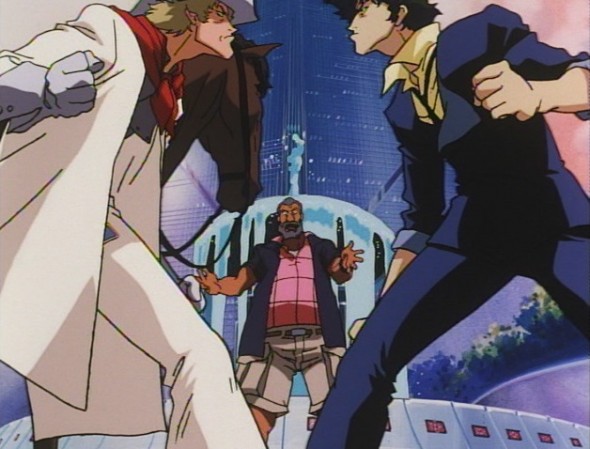
Spike and Andy end up in this kind of relationship from their first meeting, and it pretty much sets the pattern for the rest of the episode. Twice more, Teddy Bomber tries to blow up a building. Twice more, Spike and Andy show up, and in each case they’re too busy competing with eachother to pay any attention to Teddy. By the end (pictured above), they’re literally telling him to shut up and go away so that they can focus on what’s important, and he starts trying to blow the two of them up because he’s so tired of being ignored. He traps them in an elevator that’s rigged to explode, and while either of them could have gotten out easily on their own, working together… well.
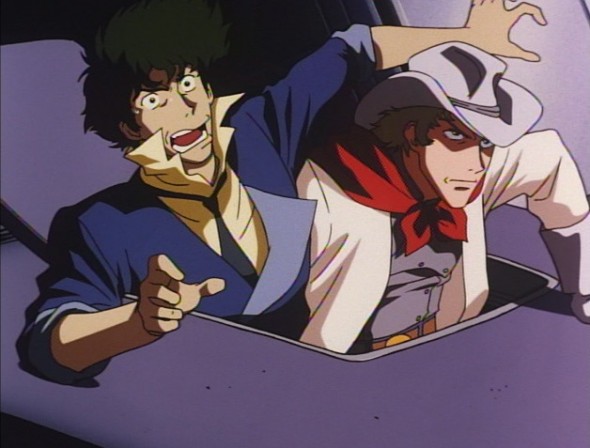
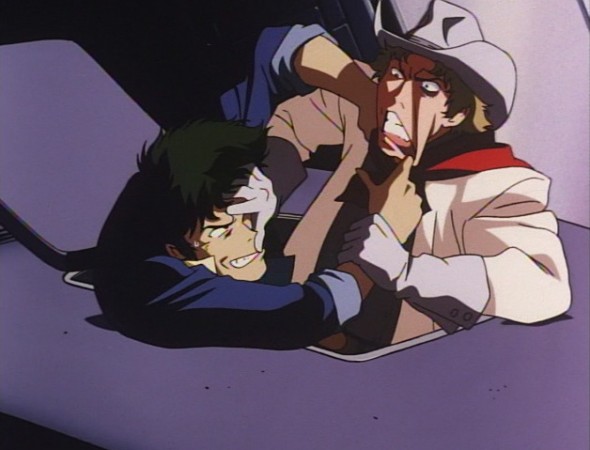
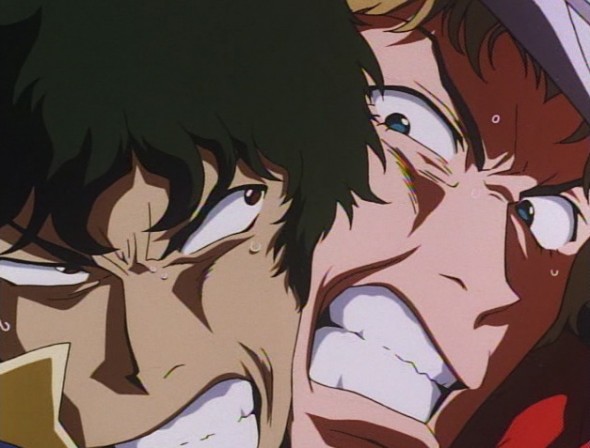
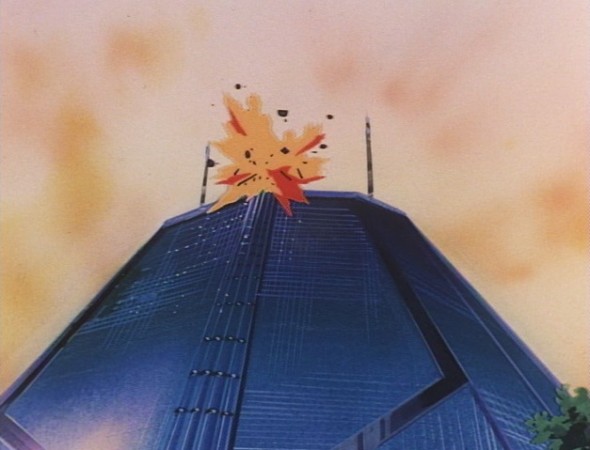
- What’s the Spike Spiegel death count at, again?
Needless to say, neither of them captures Teddy. Eventually Faye shows up and captures him in about three seconds flat. She also successfully turns him in to the police, making him the first and only major bounty that the Bebop crew ever collects. But all this is incidental to the climax of the episode, which takes place after Teddy has been arrested, with Spike and Andy duking out FOR NO REASON WHATSOEVER on top of a half-exploded skyscraper.
This is a typically awesome fight scene, and there are some interesting things about it. You will already have noticed that Andy is basically a palette-swapped version of Spike, yes? Well, they are also equally matched in badassery. But where Spike is nonchalant while he fights because he has such incredible kung fu skill, Andy either punches like a 19th-century boxer or just flails around like a nutcase. And this is more effective than Spike’s Kung Fu: Spike basically gets took to school, here.

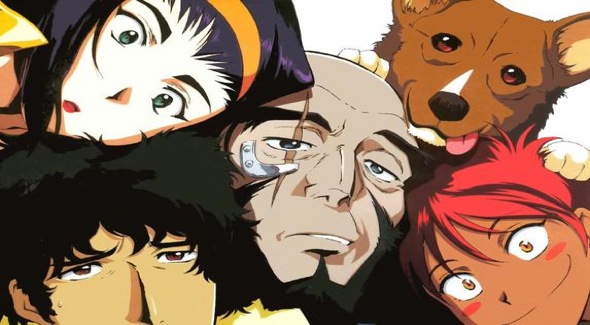
“By the way, this awesome orange color scheme is used nowhere else in the episode. In fact, the rest of it is pretty much blue, making it the extended version of that one obnoxious high-contrast color scheme they use in every single movie poster nowadays. Bebop did it before it was lame, though.”
I hope everyone is aware of this phenomenon. It’s quite striking. For an extensive gallery of examples:
http://www.slashfilm.com/2009/11/27/orangeblue-contrast-in-movie-posters/
Ah, I knew there was a gallery somewhere! I wanted to link to it but I couldn’t remember what website it was on. Thanks for that, Lee.
Although I’d call the trend more “damning” than “striking.” :-/
I can’t add anything here but I thought I would take out space and say that these articles are awesome.
Agreed. I love these articles and am really happy whenever a new one comes out.
8 pages?? F-yeah!
It’ll be a sad day when these are finished up and the series has been overthought. :D I hope you plan on doing the movie once the series is done!
One question I have about Spike’s “massive death wish.” It could be that, but I always figured Spike as a young guy to be an adrenaline junkie. He gets his thrills from dangerous situations. Unless that’s the same as a death wish. :D
I’ll probably do something about the movie… not sure quite what, though. I’ve been thinking a lot about how one could make Cowboy Bebop into a movie (because of the threatened live-action, all-Keanu-all-the-time remake), and I’m interested in how the show’s own creative team handled it. So one thought I had was to end my posts on the show itself with a list of dos and don’ts for a cinematic adaptation, and then watch the movie and see how it stacks up against that.
As for Spike’s death wish: I think at the beginning of the series, he comes off a lot more like an adrenaline junky (especially in the first episode, where he’s not interested in fighting Solensan until he realizes that the guy is nigh-indestructible), but that as the show goes on it seems more and more like he’s actually interested in finding his death, for a bunch of quasi-existential reasons. Before he goes off to fight Pierrot he actually says something like “Maybe this will finally be the one…” doesn’t he? He tries to play it off as a joke immediately afterwards, of course, but I don’t think we’re meant to believe him. I’ll go into this more in a future post, though. You bring up an interesting question.
MASSIVE SPOILER
*
*
*
*
*
*
*
*
*
*
The entire series is about death because, as we find out in the final series of episodes, Spike’s soul has basically been dead for years, and all that is left is for him to redeem his disgraceful life and die a Samurai’s death. Which of course he does.
Although, he’s marekd for death.
But, for real, the entire series is about redemption by chosing to die a good death.
In terms of Andy’s “death of cowboy identity”, what do you make of the end title reading “See You Space Samurai”? This might make the whole thing less a death than a transformation–Andy is still just as crazy, hokey and pseudo-cool as ever, he’s just swapped the superficial stereotype he’s imitating. (And even then, the cowboy stereotype arguably has a lot in common with the samurai one; you could argue that they’re similar archetypes.)
Anyway, awesome article!
I’ll see your “less a death than a transformation” and raise you a “what is death but a transformation?” When he hands Spike the hat and walks away, you’re supposed to think that his cowboy persona is dead (go ahead and put scare quotes around that if you want to). When he shows up as the samurai at the end, I find that it reads as a resurrection, or maybe a life-after-death, which amounts to pretty much the same thing.
The similarity of the cowboy and samurai archetypes is interesting, in that actual cowboys and actual samurai are about as different from each other as two groups of people have ever been. But in pop culture, they do seem to be functionally equivalent.